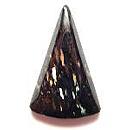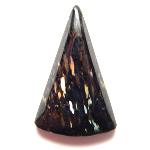|
ClassicGems.net |
|
|
 |
|
Nuummite (variety of Amphibole) |
|
|
Discovered in 1982; IMA status: Not Valid (trade name) |
|||
|
|
|
Information below is for Anthophyllite, the main constituent of Nuummite. |
|
|
Chemistry |
|
|
|
|
|
(Mg2)(Mg5)Si8O22(OH)2 |
|
|
|
Magnesium Silicate Hydroxide |
|
Molecular Weight: |
780.82 gm |
|
Composition: |
Magnesium |
21.79 % |
Mg |
36.13 % |
MgO |
|
|
Silicon |
28.78 % |
Si |
61.56 % |
SiO2 |
|
|
Hydrogen |
0.26 % |
H |
2.31 % |
H2O |
|
|
Oxygen |
49.18 % |
O |
|
|
|
|
|
100.00 % |
|
100.00 % |
= TOTAL OXIDE |
|
|
|
||||
|
Classification |
|
|
|
|
|
Silicates (Germanates) |
|
|
8/F.12-60 |
|
|
|
9 : SILICATES (Germanates)
|
|
Related to: |
Amphibole Group. Mg-Fe-Mn-Li Ortho-Amphibole Subgroup. Anthophyllite - Magnesio-Anthophyllite Series. Anthophyllite - Ferro-Anthophyllite Series. Anthophyllite - Gerdite Series. |
|
Members of Group: |
Amphibole Group: Calcic Clino-Amphibole Subgroup, Mg-Fe-Mn-Li Ortho-Amphibole Subgroup, Mg-Mn-Fe-Li Clino-Amphibole Subgroup, Sodic Clino-Amphibole Subgroup |
|
Members of Sub-Group: |
Mg-Fe-Mn-Li Ortho-Amphibole Subgroup: Anthophyllite, Ferro-anthophyllite, Ferrogedrite, Ferrohomquistite, Gedrite, Holmquistite, Protoferro-anthophyllite, Protomangano-ferro-anthophyllite, Sodicanthophyllite, Sodic-ferro-anthophyllite, Sodic-ferrogedrite, and Sodicgedrite. |
|
Varieties: |
Jenakite, Kupfferite (of Koksarov), Sahara Nuummite |
|
Synonyms: |
Nuummite: Nuumit, Nuumite, Nuummit. Anthophyllite: Anthogrammite, Anthophylline, Antofillite, Gray Asbestos, Kupferite, Magnesio-Anthophyllite. |
|
|
|
|
Crystal Data |
|
|
|
|
|
Crystals rare, to 25 cm; as bladed aggregates of unterminated prismatic crystals. Commonly lamellar or fibrous, asbestiform. |
|
|
None |
|
|
|
|
|
Physical Properties |
|
|
|
|
|
Perfect on {210}, Imperfect on {010} and {100} |
|
|
Conchoidal |
|
|
Brittle |
|
|
5.5 - 6.0 |
|
|
2.85 - 3.57 (g/cm3) |
|
|
Anthophyllite: Fluorescent, Short and Long UV = red to dark violet |
|
|
Not Radioactive |
|
|
|
|
|
Optical Properties |
|
|
|
|
|
Gray, Brownish Gray, Yellowish Brown, Clove-Brown, Brownish Green, Emerald-Green; in thin section, Colorless to pale Green or Yellow |
|
|
Opaque |
|
|
Vitreous, Pearly on cleavages |
|
|
1.598 - 1.697 Biaxial ( + ) |
|
|
0.0170 - 0.0230 |
|
|
Weak to Moderate; r > v or r < v |
|
|
When Fe-rich, moderate; X = clove-brown, yellowish brown, grayish brown; Y = clove-brown, brown-gray, brownish; Z = clove-brown to dark brown, grayish blue to green, lilac. |
|
|
Very Strong |
|
|
|
|
|
Occurances |
|
|
|
|
|
Geological Setting: |
A metamorphic rock. From medium- or high-grade metamorphism, in amphibolites, gneisses, metaquartzites, iron formations, granulites, and schists derived from argillaceous sediments, ultramafic, or mafic igneous rocks; a retrograde reaction product. |
|
Common Associations: |
Cordierite, Talc, Chlorite, Sillimanite, Mica, Olivine, Hornblende, Gedrite, Magnesio-Cummingtonite, Garnet, Staurolite, Plagioclase |
|
Common Impurities: |
Ti, Al, Mn, Ca, Na |
|
Type Locality: |
Nuummite:
Nuuk,
Vestgronland, Greenland |
|
Year Discovered: |
Nuummite:
1982 |
|
|
|
|
More Information |
|
|
|
|
|
|
Mindat.org
(Nuummite) |
|
|
|
|
The name Nuummite, which means "derived from Nuuk" in Greenlandic, is a trade name given to this unique rock type by the town council of Nuuk. The material was found in 1982 near Nuuk, Vestgronland, Greenland. Although Nuummite is said to have been discovered in 1982, the same type material was originally collected near Nuuk in 1810 by German mineralogist Karl Ludwig Giesecke (1761 - 1833) and was first scientifically defined in 1905 by Danish geologist, mineralogist and crystallographer Ove Balthasar Bøggild (1872 - 1956). Nuummite is of volcanic origin and found in Precambrian rocks formed about 3.8 billion years ago making it one of the oldest rocks found on earth. It is a rare metamorphic rock that consists primarily of the orthoamphibole minerals Anthophyllite and Gedrite with small amounts of Pyrrhotite, Chalcopyrite, Magnetite, Molybdenite, and Gahnite. Nuummite's matrix is opaque, dark gray to almost black, occassionally with a brown tinge. Set in this dark matrix are flecks and bands of iridescent play of color. The individual iridescent grains range in size from a few millimeters up to a couple of centimeters. The flashes of color include yellow, gold, copper, green, blue, red and violet. The iridescence for which Nuummite is known is the result of the interference of light reflected from alternate exsolution layers of Anthophyllite and Gedrite. Raw samples of Nuummite rarely display iridescence. This phenomenon is most apparent when a stone is cut and polished. Nuummite is also said to have strong metaphysical and spiritual healing properties. Since its discovery, Nuummite has been found in eight localities within 50 km of Nuuk, Greenland. A recent find in the Sahara Desert of Mauritania has produced material with iridescent flashes of deep blue Anthophyllite needles on a black opaque background very similar to Nuummite. This new material discovered in 2009 has been called Sahara Nuummite or Jenakite. |
|
|
Nuummite gems for sale:
|
|||||||||||||||||||||||||||

